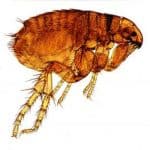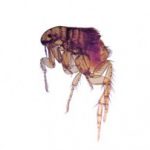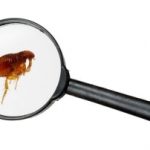Votre panier est actuellement vide !

The flea
There are more than 40 species of fleas in Canada.the flea is the most common external parasite found in dogs and cats.it is a small wingless biting insect.the adult is 1 to 4 mm long. Its body is flattened laterally (allows it to slip between the hairs) and is covered with a thick layer of chitin.the legs are long, strong and adapted for jumping which can reach 10 to 20 cm in height and up to 40 cm horizontally.only the adult stage is parasitic.
Latin Name: Pulex
Description :
There are more than 40 species of fleas in Canada.
The flea is the most common external parasite found in dogs and cats
It is a small wingless biting insect.
The adult is 1 to 4 mm long
The body is laterally flattened (allows it to slip between hairs) and
is covered with a thick layer of chitin.
The legs are long, strong and adapted for jumping which can reach
from 10 to 20 cm in height and up to 40 cm horizontally.
Only the adult stage is parasitic.
In some species of fleas, the adult feeds from a single species
animal.
Those that change hosts contribute to the transmission of several diseases,
both in animals and humans.
Adult fleas feed on blood and can be responsible for flea bite
allergic dermatitis (FAD), since their saliva contains many
allergenic substances.
In addition, they can transmit tapeworm.
It can be found in more than 50 different animal species.
It particularly affects cats, dogs, wild canines (coyote, fox, wolf),
skunks, raccoons, rodents, etc.
Reproduction:
Only the adult is found on the host.
Before mating, an adult female first takes a blood meal on
an animal or human.
The adult female lays her eggs, primarily on the animal.
The laid eggs fall out of the environment very early since they do not adhere to the
hair.
Therefore, they are found in the immediate surroundings.
The cycle completes itself in the environment. From the egg to the adult stage,
through various larval stages and the pupa (and cocoon if formed),
it can take anywhere from three weeks to a year, depending on the conditions
of the environment. Under ideal conditions of about 27 to 30ºC
and relative humidity of about 75%, the cycle will be completed between two
and four weeks.
Fleas often take a few meals a day, and this is often after
multiple test bites before gorging themselves on blood. Thus a single flea can
be responsible for many daily bites!
A female can produce about 20 eggs per day for a three-week period
(total potential egg laying of 500 eggs during her lifetime). Assuming one generation per
month, two fleas could theoretically initiate in less than three months, the production
of a population of 16 million fleas! »
Pre-emerged adult parasites can remain in their cocoons until
stimuli such as floor vibrations when the family returns from a trip or
a move into an apartment previously inhabited by infested animals.
Habits:
Larvae are more likely to be found in the living room, bedroom or rooms
where the floor or carpet provides a hiding place for them. By examining the bag that has
accumulated the debris collected by the vacuum cleaner, you may be able to observe eggs.
To check for adult fleas, wear long white socks
or place white leaves on the floor. This will help you see them better.
As the flea jumps, it attacks the feet and ankles during the day,
while any part of the body can be affected at night.
It can hide in the mattress.
There are no visible lesions following the first blood samples in humans.
Sometimes, reddish dots are clustered in a line following the exploratory activity
of the flea.
People with allergies and animals hypersensitive to the saliva it injects
subject to significant itching. This insect is said to have a clear preference
for babies and young children.
On your pet, fleas can be found just about anywhere. Inspect
(in good light) the hair on its abdomen by pulling it apart as well as other
areas where the hair is sparse.
Sometimes it is easier to observe the droppings (dried feces).
You can wipe a cotton ball soaked in detergent over the animal’s body and check
if it turns reddish upon contact with hair.
Adult fleas can live for several months without feeding, so even if you
get rid of your pets, the infestation can persist for
weeks and months, so proper treatment is needed.
Prevention:
It’s best not to put rugs all over the house, as they provide
an ideal habitat for larvae.
It’s not when your pet is around its peers that it’s most likely to get
fleas. Cats or dogs usually become infested outdoors by passing
near an infested site.
If you don’t have a pet at home, check for wild
animals or bird nests near your home.
When a person picks up an infested pet, fleas
rarely attack them. Newly emerged fleas that are holed up in
apartments are more likely to jump to the human, especially if the animal
that was present has been removed from the home.
The veterinarian can tell you what options exist to protect your pet
(and therefore your own health) before the best season, late
summer through early fall. However, fleas can be present
all year round.
Many products (shampoos, collars, etc.) have been marketed to fight
against fleas. Today, more emphasis is placed on prevention, but prescribed
treatments can also treat an existing infestation. An adulticide can
be poured on the animal’s back and a growth regulator can be administered
in tablet or injection form.
Any flea that jumps on that animal will be quickly killed or cannot have
offspring. The veterinarian can advise you on anything related to the health of
your pet. The preventive approach begins in early June and continues
through October.
Finally, treatments can be applied in the home but should
be administered by specialists to ensure that all sources
of infestation are treated.

